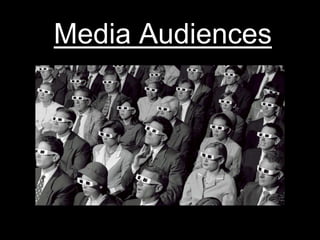
Media Audiences
- 2. Hierarchy of Needs • Maslow’s hierarchy of needs is a five-tier model of human needs shown through a diagram of a pyramid. • The needs at the bottom of the pyramid should be satisfied before the needs higher up can be. • Maslow notes that the longer deficiency of something for someone goes on, the more they’ll want it and will be motivated to get it.
- 3. Passive Audiences • It suggests that audiences directly receive or are ‘injected’ and influenced by the information transmitted via a media text. • A passive audience is normally effected by the message of the media. The audience will more likely just observe what is happening rather than actively responding to it.
- 4. The Hypodermic Needle Model • The Hypodermic Needle Model suggests that media has a direct, immediate and powerful impact on the audience. The Hypodermic Needle Model reflects the power and influence that advertising has on an audience. • This idea is suggested from the increase of radio of television, and the advertisement of films i.e from trailers, and how much of an impact this media has to make audiences go and watch a film. • The theory is thought to be a helpful tool to use to ‘inject’ people with the information and influence they want to have, to influence the response they want to get from their target audience.
- 5. Cultivation Theory • Cultivation Theory examines the long term effect that television has on audiences, and how it may change their perspective on everyday life. • The theory was originally composed by G. Gerber and later developed by Gerber & Gross. • It is believed to cultivate and effect peoples views and actions in their everyday lives, without the audience even knowing that they are being affected.
- 6. Two Step Flow Theory This theory suggests that media moves in two different ways • Opinion Leaders get their information from a media source. • Opinion Leaders pass on their own interpretations to other people i.e friends. Opinion Leaders are important as they carry lots of information that other people may not know. They pay close attention to things like the message that the source of media is trying to convey.
- 7. Active Audiences This theory asses what people do with the media that they have experienced. The theory suggests that they may apply what they have experienced within the media in their everyday lives.
- 8. Reader Response Theory • It is a readers response to a literary text. • The theory is not passive, the way that the reader interprets it depends on the individuals own background and life experiences. • The theory has been developed by Stuart Hall and he developed three hypothetical interpretive codes for the readers of the text.
- 9. Reader Response Theory 1. Dominant reading is where the text is read in the way that the writer or producer intended it to be read. Dominant reading is like a source of advertising, as normally the audience will agree and follow along with the message. Dominant reading has to consider the culture, age and society. 2. Negotiated reading is similar to dominant reading in the sense that the audience should acknowledge the views and message that the producer is portraying. However the audience is more likely to also add their own interpretation, they make their own judgement. The audience may not fully understand the reading and its messages, or may just not relate to the message being portrayed. 3. Oppositional reading is where the audience rejects the producers intended reading, and instead the audience creates their own interpretation and reading, which contrasts with what the producer intended. Oppositional reading is very negative for a producer. For example if a dress is being advertised, it will make the audience not want to buy it at all for the ways it has been advertised. For example they may have found the advert intensive. This is obviously not what the producer intended. The audience may not agree with the producers messages. Oppositional reading tends to come around from a product or advertisement that may have controversial themes, or if it has a message which is not understood properly.
- 10. Uses and Gratification Model This theory focusses more on the consumer, audience, or the message itself by asking the question “what do people do with media” rather than “what media does to people”. The theory notices the people make an active effort to interpret media into their own lives. This theory therefore suggests that media competes against other information sources for viewers gratification.
- 11. Uses and Gratification Model The Basic Model surges that the uses and gratification theory has to fulfil on of the following when choosing a form of media: - Identify: By allowing the audience to recognise the product or person presented. - Educate: being able to digest information and understanding. - Entertain: The audience should enjoy the method of advertisement used to sell product to them, make them remember the product and make them want to go out and buy it. - Social Interaction: To make the media product to spark a conversation with people, to keep the product relevant and up for discussion, therefore making it more appealing.